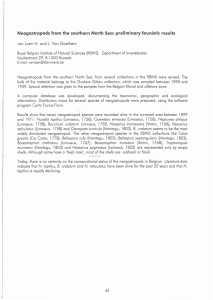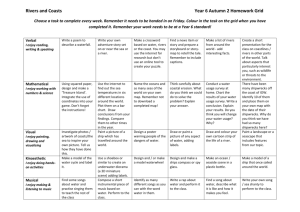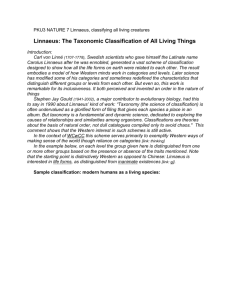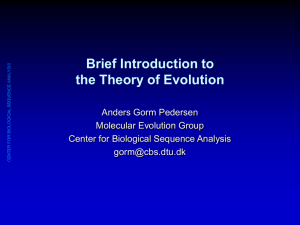Artificial hard substrata from the Belgian part of the North... and their influence on the distributional range of species
advertisement
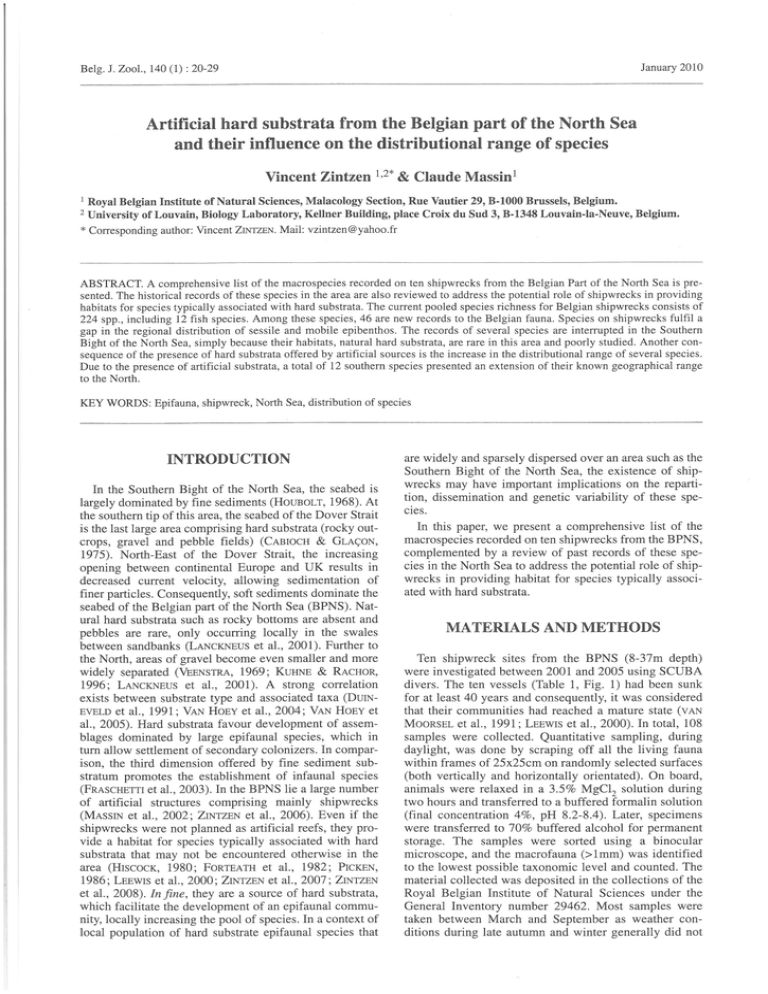
January2010 Belg. J. Zool., 140 (l) : 20-29 Artificial hard substrata from the Belgian part of the North Sea and their influence on the distributional range of species Vincent Zintzen 12* & CIaude Massin Royal Belgian Institute ofNatural Sciences, Malacology Section, Rue Vautier 29, B-1000 Brussels, Belgium. 2 University of Louvain, Biology Laboratory, Kellner Building, place Croix du Sud 3, B-1348 Louvain-la-Neuve, Belgium. * Con-esponding author: Vincent ZINTZEN. Mail: vzintzen@yahoo.fr ABSTRACT. A comprehensive list of the macrospecies recorded on ten shipwrecks from the Belgian Part of the North Sea is presented. The historical records of these species in the area are also reviewed to address the potential role of shipwrecks in providing habitats for species typically associated with hard substrata. The current pooled species richness for Belgian shipwrecks consists of 224 spp., including 12 fish species. Among these species, 46 are new records to the Belgian fauna. Species on shipwrecks fulfil a gap in the regional distribution of sessile and mobile epibenthos. The records of several species are interrupted in the Southern Bight of the North Sea, simply because their habitats, natural hard substrata, are rare in this area and poorly studied. Another con- sequence of the presence of hard substrata offered by artificial sources is the increase in the distributional range of several species. Due to the presence of artificial substrata, a total of 12 southern species presented an extension of their known geographical range to the North. KEY WORDS: Epifauna, shipwreck, North Sea, distribution of species INTRODUCTION In the Southern Bight of the North Sea, the seabed is largely dominated by fine sediments (HOUBOLT, 1968). At the southern tip of this area, the seabed of the Dover Strait is the last large area comprising hard substrata (rocky outcrops, gravel and pebble fields) (CABIOCH & GLAQON, 1975). North-East of the Dover Strait, the increasing opening between continental Europe and UK results in decreased current velocity, allowing sedimentation of finer particles. Consequently, soft sediments dominate the seabed of the Belgian part of the North Sea (BPNS). Natural hard substrata such as rocky bottoms are absent and pebbles are rare, only occumng locally in the swales are widely and sparsely dispersed over an area such as the Southern Bight of the North Sea, the existence of shipwrecks may have important implications on the repartition, dissemination and genetic variability of these species. In this paper, we present a comprehensive list of the macrospecies recorded on ten shipwrecks from the BPNS, complemented by a review of past records of these species in the North Sea to address the potential role of shipwrecks in providing habitat for species typically associated with hard substrata. MATERIALS AND METHODS between sandbanks (LANCKNEUS et al., 2001). Further to Ten shipwreck sites from the BPNS (8-37m depth) the North, areas of gravel become even smaller and more widely separated (VEENSTRA, 1969; KUHNE & RACHOR, were investigated between 2001 and 2005 using SCUBA 1996; LANCKNEUS et al., 2001). A strong con-elation divers. The ten vessels (Table l, Fig. l) had been sunk exists between substrate type and associated taxa (DUINfor at least 40 years and consequently, it was considered EVELD et al., 1991; VAN HOEY et al., 2004; VAN HOEY et al., 2005). Hard substrata favour development of assemblages dominated by large epifaunal species, which in turn allow settlement of secondary colonizers. In comparison, the third dimension offered by fine sediment substratum promotes the establishment of infaunal species (FRASCHETTI et al., 2003). In the BPNS lie a large number of artificial structures comprising mainly shipwrecks that their communities had reached a mature state (VAN MOORSEL et al., 1991; LEEWIS et al., 2000). In total, 108 samples were collected. Quantitative sampling, during daylight, was done by scraping off all the living fauna within frames of 25x25cm on randomly selected surfaces (both vertically and horizontally orientated). On board, animals were relaxed in a 3.5% MgCl^ solution during two hours and transferred to a buffered formalin solution (MASSIN et al., 2002; ZINTZEN et al., 2006). Even if the (final concentration 4%, pH 8.2-8.4). Later, specimens shipwrecks were not planned as artificial reefs, they provide a habitat for species typically associated with hard substrata that may not be encountered otherwise in the were transferred to 70% buffered alcohol for permanent area (HISCOCK, 1980; FORTEATH et al., 1982; PICKEN, 1986; LEEWIS et al., 2000; ZINTZEN et al., 2007; ZINTZEN et al., 2008). In fine, they are a source of hard substrata, which facilitate the development of an epifaunal community, locally increasing the pool of species. In a context of local population of hard substrate epifaunal species that storage. The samples were sorted using a binocular microscope, and the macrofauna (>lmm) was identified to the lowest possible taxonomie level and counted. The material collected was deposited in the collections of the Royal Belgian Institute of Natural Sciences under the General Inventory number 29462. Most samples were taken between March and September as weather conditions during late autumn and winter generally did not Fauna of shipwrecks 21 TABLEl Studied shipwreck sites. WGS-84 COORDINATES SHIPWBECK SITES Birkenfels DEPTH (MLLWS) (m) DATF. OP SUNK &UMPUNG VEABS (20M) N51°38',989E02°32',268 37 1966 01-02-03-04-05 2 - Callisto N51°41',950E02°37',330 28 1959 04-05 3 - Garden City 26 1969 05 4 - John Mahn N51°29',170E02°18',320 N51°28',930E02°41',350 29 1942 05 5 - Duc de Normandie N51°25',524E02°36',345 29 1942 05 6 - LCT 457 N51°24',670E02°43',720 21 1944 05 7 - Kilmore N51°23',730E02°29',790 30 1906 03-04-05 8 - Bourrasque N5I°14',964E02°33',026 N51°15',510E02°40',830 18 1940 02-03-04-05 9 - LST 420 8 1944 05 10 - Sperrbrecher N51°16',650E02°49',780 9 1942 04 >, f / ^ 51">3 SS- s.' * .2 c fll a ^ fr a r b sriï o ü tt Q 4 o ^ o .f c s> 5 o s -. t . o Si' l.-». g ^.^^^.^.&^ li n UK tf fr ^ I gi urn; ,f ^^.1) B o 5^17' tT y v 8 B .n ^ The Netheriands a B B è. .....! .w u fl N^Ï n o ft UOf tt eebnjgge a. The Nethertands de t. n ü ^ \ x ? France Belgium ^ ^ 50">9'-i \ \ / f" / ^J.^ o France x o 100 IS 30 kilometers a 200 3(Kj ofiïfiters ^ t>7 2'3S 309' Begian Continental $heif Shipwrecks 3*40' 4*11 ^i^^~,LOC?li^a!ion ofthestudied shiPwrecks:l: Birkenfels, 2: Callisto, 3: Garden City, 4: John Mahn, 5: Duc de Normandie, 6: LCT 457, 7: Kilmore, 8: Bourrasque, 9: LST 420, 10: Sperrbrecher. Source: Afdeling Waterwegen Kust, Belgium. allow sampling. Species only recorded between October area of study. From this information, the implications of shipwrecks from the BPNS were defined as either (l) filling a gap in the distributional range of the species if the and February are presented in a separate table. Some species were also recorded as in situ observations by divers and digital picture analysis. They are also presented in a » species was recorded North and South of the BPNS or (2) separate table. Rare species are defined as those mentioned once or twice in past studies. permitting an extension of the distributional range to the North or to the South. In addition, we reviewed the historical records of these species in the BPNS by screening regional faunal listings (GOVAERE, 1978; CATTRUSSE & VlNCX, 2001; DAUVIN et RESULTS al., 2003; DEGRAER et al., 2006) and the Zoological Record for the last 30 years. For records considered new to the area, we went through the literature to compile dis- tributional ranges at the scale of the North Sea and surrounding area. Species were defined either as Northern species, if their distributional range was restricted to the Northern part of the North Sea, or as Southern species if they were only recorded from the Lusitanian Province. The distributional range was further refined as 'Southern North Sea' if the species was recorded as far North as Helgoland, or 'Northern North Sea' if the range extended South to this point. Species are defined as cosmopolitan if they have been previously recorded outside the present The species richness and average density ranges for the different shipwrecks between March and September (2001-2005) are presented in Table 2. The species richness for the period March-September totals 193 species. Another nine species were only sampled between Öctober and Febmary (Table 3). An additional 22 species were observed in situ or after examination of digital pictures (Table 4). Consequently, the pooled species richness for Belgian shipwrecks is 224 spp. Of these species, 46 can be considered new to the Belgian fauna (Table 5). Their actual distributions in the North Sea are given in this table. Most of the species mentioned in our study have 22 Vincent Zintzen & Claude Massin been recorded from north and south of the BPNS, spongites, Lysianassa ceratina). Some species rare for the although ten species have a meridional distribution, with shipwrecks extending their distribution to the north (Actinothoe sphyrodeta, Eulalia aurea, Lysidice ninetta, Marphysa sanguinea, Polydora hoplura, Sphaerosyllis bulbosa, Thelepus setosus, Tritonia manicata, Acasta area have also been recorded (Table 6). Although our results are focussed on the fauna of shipwrecks, we note that no macroalgae were either seen or sampled by divers at any time. TABLE 2 Distribution of the epifaunal species on the ten investigated shipwrecks. Only the data collected between April and September are used. Sites are ordered from offshore to coastal zone. BRK: Birkenfels (N=25 samples of 25x25cm), CAL: Callisto (N=7), GAR: Garden City (N=3), JON: John Mahn (N=3), DUC: Duc de Normandie (N=3) LCT: LCT 457 (N=3), KLM: Kilmore (N=32), BRQ; Bourrasque (N=23), LST: LST 420 (N=3), SPR: Sperrbrecher (N=6). A simplified scale ofdominance was attributed to the colonial species: ] . present, .. abundant, ... dominant. l BRK CAL GAR JON DÜCC,Cr-IKT-B5Q Ï'ST SPR PÓWFERA Dysideafragïis (Montagu, 1818) . . Esperiopsis fucorum (Esper, 1794) Halichondria cfpanicea (Pallas, 1766) Haliclona oculata (Pallas, 1766) Haliclona sp. Hymeniacidon perlevis (Montagu, 1818) Leucosolenia sp. Myxilla rosacea (Lieberkühn, 1859) Phorbas plumosus (Montagu, 1818) Sycon ciliatum (Fabricius, 1780) . . . . . .. . . . . . . . . . . . . .. . . . . .. . .. .. .. .. CNIDAWA Hydrozoa Bougainvillia muscus (Allman, 1863) Campanularia volubilis (Linnaeus, 1758) Clytia gracilis (Sars, 1850) Clytia hemisphaerica (Linnaeus, 1767) Halecium sp. Hydractinia echinata (Flemming, 1828) . . . . . . . . . . Hydrallmania falcata (Linnaeus, 1758) Laomedea flexuosa Alder 1857 . Nemertesia antennina (Linnaeus, 1.758) Obelia bidentata Clarke, 1875 » Sarsia eximia (Allman, 1859) . . . . Tubularia larynx Ellis & Solander, 1786 .. ... ... ... ... ... .. ... ... .. .. .. .. ... -'7 Ind.m-2 0-10 101 (X) ANTHOZOA Actiniaria Alcyonium digitatum Linnaeus, 1758 Diadumene cincta Stephenson, 1925 . . Sertularia cupressina Linnaeus, 1758 Tubularia indivisa Linnaeus, 1758 . . ^ v^ ' ^^^^s^^^^^v Metridium senile (Linnaeus, 1767) PLATYHELMINTHES Eurylepta comuta (O.F. Muller, 1776) Turbellaria NEMERTEA ï Baseodiscus delineatus (Delle Chiaje, 1825) Nemertinata sp. Oerstedia dorsalis (Abildgaard, 1806) 1 c" -fr ANNELIDA POLYCHAETA Alentia gelatinosa (M. Sars, 1835) Autolytus sp. Cirratulidae t2j V-^-Zj FlS Cirratulus cirratus (O.F. Muller, 1776) f n' Cirratulus filiformis Keferstein, 1862 Cirratulus sp. Cirriformia tentaculata (Montagu, 1808) Dipolydora coeca (Oersted, 1843) Eteone longa (Fabricius, 1780) Eteonepicta Quatrefages, 1865 k_l Fauna of shipwrecks 23 TABLE 2 Distribution of the epifaunal species on the ten investigated shipwrecks. Only the data collected between April and September are used. Sites are ordered from offshore to coastal zone. BRK: Birkenfels (N=25 samples of 25x25cm), CAL: Callisto (N=7), GAR: Garden .- City (N=3), JON: John Mahn (N=3), DUC: Duc de Normandie (N=3) LCT: LCT 457 (N=3), KLM: Kilmore (N=32), BRQ: Bourrasque (N=23), LST: LST 420 (N=3), SPR: Sperrbrecher (N=6). A simplified scale of dominance was attributed to the colonial species: . present, .. abundant, . . . dominant. BRK CAL GAR JON Eulalia aurea TGravier, 1896 SPR DUC LCt KLM BRQ LS1 l_l Eulalia sp. ~] Eulalia viridis (Linnaeus, 1768) Eumida sp. Eupolymnia nebulosa (Montagu, 1818) Eupolymnia nesidensls (Delle Chiaje, l 828) Eusyllis blomstrandi Malmgren, 1867 Gattyana cirrhosa (Pallas, 1766) Harmothoe sp. Kefersteinia cirrata (Keferstein, 1862) Lanice conchilega (Pallas, 1766) Lepidonotus squamatus (Linnaeus, 1758) Lumbrineris latreilli Audpuin & Milne-Ed., 1834 Lumbrineris sp. Marphysa sanguinea (Montagu, 1815) Neoamphitrite figulus (Dallyell, 1853) Nereimyra punctata (O.F. Muller, 1788) Nereis pelagica Linnaeus, 1758 Nicolea venustula (Montagu, 1818) c=r I Nicomache sp. Ophelia sp. Owenia fusiformis Delle Chiaje, 1842 Pectinaria koreni (Malmgren, 1866) Pholoe inornata Johnston, 1839 u l-l Phyllodoce longipes Kinberg, 1866 Phyllodoce mucosa Oersted, 1843 Phyllodoce sp. Ind.m" Pista cristata (O.F. Muller, 1776) 0-10 IÖ-1ÖÖ Poecilochaetus serpens Allen, 1904 Polycirrus sp. Polydora hoplura Claparède, 1870 Polydora sp. Pomatoceros triqueter (Linnaeus, 1758) Proceraea sp. Procerastea halleüana Mallaquin, 1893 Procerastea nematodes Langerhans, 1884 Sabellaria spinulosa Leuckart, 1849 Scoloplos armiger (Allman, 1859) Sphaerodoropsis flavum Oersted, 1843 Sphaerosyllis bulbosa Southem, 1914 Sphaerosyüis sp. I 3 Sthenelais boa (Johnston, 1833) Subadyte pellucida (Ehlers, 1864) Syllidae Syllis armülaris (O.F. Muller, 1776) Syllis gracilis Grube, 1840 1 Terebellidae Thelepus cincinnatus (Fabricius, 1780) Thelepus setosus (Quatrefages, 1865) MOLLUSCA GASTROPODA Aeolidiidae Archidoris pseudoargus (Rapp, 1827) Catriona gymnota (Couthouy, 1838) Cerithiopsis tubercularis (Montagu, 1803) Crepidula fomicata (Linnaeus, 1758) Cuthona amoena (Alder & Hancock, 1845) Cuthona concinna (Alder & Hancock, 1843) Cuthona sp. Dendronotus frondosus (Ascanius, 1774) ez Jl ^^w^ 24 Vincent Zintzen & Claude Massin TABLE 2 Distribution of the epifaunal species on the ten investigated shipwrecks. Only the data collected between April and September are used. Sites are ordered from offshore to coastal zone. BRK: Birkenfels (N=25 samples of 25x25cm), CAL: Callisto (N=7), GAR: Garden City (N=3), JON: John Mahn (N=3), DUC: Duc de Normandie (N=3) LCT: LCT 457 (N=3), KLM; Kilmore (N=32), BRQ: Bourrasque (N=23), LST: LST 420 (N=3), SPR: Sperrbrecher (N=6). A simplified scale of dominance was attributed to the colonial species: . present, .. abundant, ... dominant. BRK^CAL ^AR^ JON DUC LCT KLM BRQ tór^ SPft Dato pinnatifida (Montagu, 1804) Epitonium clathratulum (Kanmacher, 1798) Eubranchus pallidus (Alder & Hancock, 1842) Eubranchus sp. Euspira pulchella (Risso, 1826) Facelina bostoniensis (Couthouy, 1838) Lamellaria latens (O.F. Muller, 1776) Nassarius incrassatus (Ström, 1768) Nassarius reticulatus (Linneaus, 1758) Raphitoma linearis (Montagu, 1803) Rissoidae Tergipes tergipes (Forskal, 1775) Tritonia cfmanicata Deshayes, 1853 Tritonia plebeia Johnston, 1828 Trivia monacha (da Costa, 1778) BlVALVIA Aequipecten opercularis (Linnaeus, 1758) Heteranomia squamula (Linnaeus, 1758) Musculus sp. Mysella bidentata (Montagu, 1803) Mytilus edulis Linnaeus, 1758 ^ ^ ~5 L ~1 Ostreidae Venerupis geographica (Gmelin, 1791) Venerupis sp. B SlPUNCULA Ind.m-2 Golfingüda CRUSTACEA COPEPODA 0-10 Copepoda ,' ClRRIPEDIA Acasta spongites (Poli, 1795) Balanus crenatus Bruguiére, 1789 .-l 'l Verruca stroemia Of. Muller, 1776 m CUMACEA Cumacea ISOPODA Janira maculosa Leach, 1814 Pleurocrypta porcellanae Hesse, 1876 AMPHIPODA Abludomelita obtusata (Montagu, 1813) Atylus swammerdami (Milne-Edwards, 1830) Caprella linearis (Linnaeus, 1767) Caprella tuberculata Guérin, 1836 Iphimedia nexa Myers & McGrath, 1987 Jassa herdmani (Walker, 1893) Lysianassa ceratina (Walker, 1889) Melita hergensis Reid, 1939 Metopa alderi (Bate, 1857) Monocorophium acherusicum (Costa, 1851) Monocorophium sextonae (Crawford, 1937) iaai ; Pariambus typicus (Kroyer, 1844) Phtisica marino Slabber, 1769 yf Pseudoprotella phasma (Montagu, 1804) T Stenothoe marino (Bate, 1856) . ..!,;- Stenothoe monoculoides (Montagu, 1815) Stenothoe sp. Stenothoe valida Dana, 1855 DECAPODA Anapagurus chiroacanthus (Lilljeborg, 1856) Atelecyclus rotundatus (O)ivi, 1792) .-u'? '.^ ns. r ?..vt^l' ,+_ <LL ^i. ;^i' r 25 Fauna of shipwrecks TABLE 2 Distribution of the epifaunal species on the ten investigated shipwrecks. Only the data collected between April and September are used. Sites are ordered from offshore to coastal zone. BRK: Birkenfels (N=25 samples of 25x25cm), CAL: Callisto (N=7), GAR: Garden City (N=3), JON: John Mahn (N=3), DUC: Duc de Normandie (N=3) LCT: LCT 457 (N=3), KLM: Kilmore (N=32), BRQ: Bourrasque (N=23), LST: LST 420 (N=3), SPR: Sperrbrecher (N=6). A simplified scale ofdominance was attributed to the colonial species: . present, .. abundant, ... dominant. SFK BRK CAL GA» JON DUC tCT 1SLM BRQ LS»t Ebalia tumefacta (Montagu, 1808) Hyas araneus (Linneaus, 1758) Inachus phalangium (Fabricius, 1775) Liocarcinus arcuatus (Leach, 1814) Liocarcinus holsatus (Fabricius, 1798) Liocarcinus sp. ^mu; |_: 3 Macropodia parva Van Noort & Adema, 1985 Macropodia rostrata (Linnaeus, 1761) Macropodia sp. Necora puber (Linnaeus, 1767) Paguridae Pilumnus hirtellus (Linnaeus, 1761) .^ Pisidia longicomis (Linneaus, 1767) Thoralus cranchii (Leach, 1817) CHELICERATA PYCONOGONIDA Achelia sp. ^^^^j^yy^^^^^ Callipallene emacinata (Dohm, 1881) Nymphon rubrum Hodge, 1865 Pycnogonum littorale (Strom, 1762) BRYOZOA CYCLOSTOMATIDA Crisia aculeata Hassall, 1841 Disporella hispida (Fleming, 1828) Plagioecia patina (Lamarck, 1816) _7 Ind.m-z 0-10 . no-ioo" . . . CHEILOSTOMATIDA Bicellariella ciliata (Linnaeus, 1758) Conopeum reticulum (Linnaeus, 1767) Electra pilosa (Linnaeus, 1767) Scruparia chelata (Linnaeus, 1758) Scrupocellaria scruposa (Linnaeus, 1758) . . . .. .. .. .. .. .. . . .. . CTENOSTOMATIDA Alcyonidium hydrocoalitum Porter, 2004 . Panolicella nutans Jebram, 1985 . . Vesicularia spinosa (Linnaeus, 1967) ECHINODERMATA ASTEROIDEA j Asterias rubens Linnaeus, 1758 Asterias rubens juv. Linnaeus, 1758 . ECHINOIDEA Euechinoidea Psammechinus miliaris (Gmelin, 1778) OPHIUROIDEA Amphipholis squamata (Delle Chiaje, 1829) Ophiothrixfragilis (Abildgaard, 1789) Ophiura albida Forbes, 1839 ;v Ophiura sp. CHORDATA TUNICATA Ascidiacea Diplosoma sp. Molgula cf occulta Kupffer, 1875 Polyclinum aurantium Milne-Edwards, 1841 . .. .. .. .. ez: .. .. . . Vincent Zintzen & Claude Massin 26 TABLE 3 TABLE 4 Distribution of the epifaunal species exclusively recorded Species observed in situ by divers or from digital images but not between October and March. Sites are ordered from offshore to coastal zone. BRK: Birkenfels (N=7), KLM: Kilmore (N=14), sampled. BRQ: Bourrasque (N=12). A simplified scale ofdominance was attributed to the uncountable species: .: present, ..: abundant, CNIDARIA ANTHOZOA Urticina felina (Linnaeus, 1767) 2 ...: dominant. Density never exceeded 10 individuals.m Sagartia sp. (grey). BRK' KIM' ÖRQ PORIFERA Mycale cïmacilenta (Bowerbank, 1866) Ed., 1833 CRUSTACEA DECAPODA LL Suberites ficus (Esper, 1794) ANNELIDA POLYCHAETA Eunicidae Lysidice ninetta Audouin & Milne- Sagartiogeton undatus (O.F. Muller, 1788) Actinothoe sphyrodeta (Gosse, 1858) Cancer pagurus Linnaeus, 1758 MOLLUSCA CEPHALOPODA . Loligo vulgaris Lamarck, 1798 - eggs Acanthodoris pilosa (Abildgaard in O.F. Muller, 1789) BRYOZOA rj CYCLOSTOMATIDA Bugula cï turhinata Alder, 1857 NERMERTEA CHORDATA TUNICATA Tubulanus sp. MOLLUSCA GASTEROPODA Ascidiella scabra (OF. Muller, 1776) Clavelina lepadiformis O.F. Muller, 1776 Tergipes tergipes (Forskal, 1775) PlSCES CRUSTACEA CUMACEA Dicentrarchus labrax (Linnaeus, 1758) Gadus morrhua Linnaeus, 1758 Bodotria arenosa Goodsir, 1843 Myoxocephalus scorpius (Linnaeus, 1758) Parablennius gattorugine (Linnaeus, 1758) Pollachius poüachius (Linnaeus, 1758) AMPHIPODA Amphilochus manudens Bate, 1862 l DECAPODA Pollachius virens (Linnaeus, 1758) Pomatoschistus sp. Scomber scombrus Linnaeus, 1758 Pagurus cuanensis Bell, 1845 Spondyliosoma cantharus (Linnaeus, 1758) Trisopterus luscus (Linnaeus, 1758) Trisopterus minutus (Linnaeus, 1758) Trachurus trachurus (Linnaeus, 1758) TABLE 5 Species (from shipwrecks) that are new records for the Belgian fauna. SNS: Southem North Sea species, NNS: Northern North Sea species, NC: indicates the presence of the species in the neighbouring countries (fr: France, nl: The Netherlands, uk: United Kingdom), SS: Southern species, NS: Northern species, COS: cosmopolitan species, HS (Hard Substrata) CONSEQUENCES: the implication of the presence of the Belgian shipwreck for the distributional range of species. ?: information unavailable. See text for detailed explanations of the distributional ranges. (< AXON SNS NNS NC ss NS + cos BS CWSEQVENCES PORIFERA + + + fr,uk fr,uk + + + + fr,uk fr,uk,nl + Diadumene cincta PLATYHELMINTHES Eurylepta cornuata + + fr,uk + + + Alentia gelatinosa + + Cirratulus cirratus + + Cirriformia tentaculata + Dipolydora coeca Eteone picta + Dysidea fragilis Phorbas plumosus fill in the gap fill in the gap CNIDARIA Actinothoe sphyrodeta ( NEMERTEA Oerstedia dorsalis POLYCHAETA fill in the gap + fill in the gap fr,uk,nl + fill in the gap + fill in the gap + fr,uk fr,uk,nl fr,uk + + fr,uk + fill in the gap fill in the gap fill in the gap fr,uk,nl fr,uk + Eulalia aurea Eupolymnia nebulosa Eupolymnia nesidensis Lysidice ninetta extension to the north + + + fr,uk,nl + + fr.uk fr,uk fill in the gap + extension to the north + + + + fill in the gap + fill in the gap + extension to the north T~ Fauna of shipwrecks 27 TABLE 5 Species (from shipwrecks) that are new records for the Belgian fauna. SNS: Southern North Sea species, NNS:NorthemNorth Sea species, NC: indicates the presence of the species in the neighbouring countries (fr: France, nl: The Netherlands, uk: United Kingdom), SS: Southern species, NS: Northem species, COS: cosmopolitan species HS (Hard Substrata) CONSEQUENCES: the implication of the presence of the Belgian shipwreck for the distributional range of species. ?: information unavailable. See text for detailed explanations of the distributional ranges. FAXON Marphysa sanguinea Neoamphürite figulus Nereimyra punctata SNS NNS + Phyllodoce longipes M'. ss fr,uk + + + + + fr,uk,nl fr,uk,nl + + fr.uk NS + Polydora hoplura Procerastea halleyana Procerastea nematodes + fr,uk + fr.uk Sphaerodoropsis flavum Sphaerosyllis bulbosa Subadyte pellucida + + + Thelepus cincinnatus Thelepus setosus + + + + fill in the gap fill in the gap from the north * fr,uk,nl fr,uk,nl fr,uk + extension to the north + fill in the gap fill in the gap fill in the gap + ? fr,uk + fill in the gap fill in the gap + fr,uk + HS'CONSEQUKNCES extension to the north + + + Pista cristata cos extension to the north + + fill in the gap fill in the gap + extension to the north + + GASTROPODA Cerithiopsis lubercularis + Cuthona amoena Cuthona concinna + + + + + Raphitoma linearis Tritonia cf manicata CRUSTACEA Acasta spongites Caprella tuberculata + + fr,uk fr,uk,nl fr,uk,nl fr,uk fill in the gap fill in the gap + + Pleurocrypta porcellanae + Pseudoprotella phasma Anapagurus chiroacanthus + fill in the gap + extension to the north fr,uk fr,uk + extension to the north Macropodia parva + fr,uk,nl + + + fill in the gap from the north uk fill in the gap + extension to the north fr,uk Lvsianassa ceratina + fill in the gap fill in the gap + fr,uk fr,uk fr,uk,nl fill in the gap + fill in the gap PYGNOGONIDE Callipaüene emacinala BRYOZOA Crisia aculeata + Alcyonidium cellarioides + Nolella pusilla + + fr,uk + fr,uk,nl fr,uk,nl fr,uk,nl + 1 fill in the gap + fill in the gap and in extension to the north fill in the gap and in extension to north TüNICATA Clavelina lepadiformis + + Polyclinum aurantium + + TABLE 6 Species (from Belgian shipwrecks) that could be considered rare for the Belgian fauna (mentioned only one or two times in past studies). PORIFERA Hymeniacidon perlevis Esperiopsis fucorum CNIDARIA Sagartiogeton undatus CRUSTACEA Iphimedia nexa Atelecyclus rotundatus Inachus phalangium PYCNOGONIDE Pycnogonum littorale i ^ ^ Tunicata Ascidiella scabra fr,uk,nl fr,uk,nl fill in the gap fill in the gap DISCUSSION The species richness of the shipwreck macrofauna from our studies is 224, including 12 fish species observed in situ by divers. This is in the range of the spe- cies richness observed for soft sediment macrofauna of the BPNS where DEGRAER et al. (2006) identified a total of 265 species from 771 Van Veen grab samples. Taking into account that we collected only one-sixth the number of samples as did DEGRAER et al. (2006) and that shipwrecks represent a relatively small area compared to the continental shelf, we hypothesize that these artificial hard substrata concentrate species richness. In this respect, they can be considered as hot spots of species richness. The number of species recorded as new to the Belgian fauna is high (46 spp.). It appears that shipwrecks fulfil a gap in the regional distribution of sessile and mobile epibenthos for these species. Shipwrecks provide a habitat suitable for typically hard substrate-associated species found further South and extend the range of populations -r- 28 Vincent Zintzen & Claude Massin previously found restricted to the Dover Strait (DAVOULT, However, the dominant sessile species are different. In 1990). The distribution of several species is interrupted in the Southern Bight of the North Sea, simply because their Dover Strak pebble beds, the sessile fauna is mostly dominated by bryozoan species, the hydrozoan Alcyonium digi- habitat, natural hard substrata, is rare in this area and has tatum and the anthozoan Urticina felina, while the largest been pooriy studied. The Paguridae Anapagurus chiroacanthus is a nice example of such a distribution (GARCIAGOMEZ, 1994). It is present from Norway to the Azores, fraction of the sessile epifauna of wrecks consists of cnidarians (Tubularia spp. and Metridium senile) (ZINTZEN et al., 2007; ZINTZEN et al., 2008). The causes for such a pat- but is not recorded in the Southern North Sea. Its presence tem could be abiotic factors that control the recruitment on shipwrecks of the BPNS fills the gap between populations living along the coast of France and Germany. Por these species, it is possible that shipwrecks favour transfer by stepping-stone effect between local populaüons. Other species such as the sea anemone Actinothoe sphyrodeta, have their northem limit extended by shipwrecks (see WILLIAMS, 1997). The sponge-inhabiting bamacle Acasta spongites was also described for the first time_during this study as inhabiting the Southern Bight of the and development of these assemblages. Another factor that potentially separates pebble beds and shipwrecks is ples, the hard substrata offered by artificial sources extend the range of these species. Table 2 shows 12 species presenting another extension of geographical range from mode on both habitats. The rate of partiële filtration by a North Sea (ZINTZEN & KERCKHOF, 2009). In these exam- South to North. In this study, we did not detect any poten- tially invasive species, exceptjuveniles of Crepidulafomi- cata which have been found in small densities. However, this network of artificial hard substrata may also facilitate the dispersal of invasive species that need hard substrata to complete their life cycle. In a context of global warming, the presence of artificial hard substrate spots, _which include shipwrecks, may significantly reduce the physical barriers, such as large areas of soft sediments, preventing the northward spreading of warm-water species No algal species were identified on subtidal Belgian habitats, either on soft sediments (VAN HOEY et al., 2004) or shipwrecks. In contrast, intertidal zones in harbours and groynes the stability of the substratum. Particularly strong currents or storm events may have a more profound effect on pebbles than on large rigid structures (POSEY et al., 1996). Pebbles can be moved and the epifauna damaged, promot- ing the dominance of species tolerant to physical disturbance. On shipwrecks, large storm events can lead to collapse of a part of the superstmcture but frequent small scale perturbation events are unlikely to occur. Passive suspension feeding seems to be the dominant feeding specimen is a function of partiële density and current velocity. This last parameter could be enhanced on shipwrecks since current speed is higher at increasing distance from the bottom, influencing the final pattern of dominat- ing species. Finally, human activities, such as commercial fishing, are more intense on smooth grounds such as pebbles than on shipwrecks, also leading to more frequent perturbation. These disturbances all have a strong effect on the development of epibenthic species (ENGEL & KVITEK, 1998; FRASCHETTI et al., 2001). ACKNOWLEDGEMENTS The authors wish to thank the Station Marine de AERT et al., 2002). The absence of Chlorophyta and Phaeo- Wimereux for providing species list from the Dover Strait pebble community. The authors also wish to thank the linked to turbid conditions, abrasion of sand close to the bot- also want to thank Mr Andrew Stewart for his careful torn or competition with fast-growing sessile invertebrates such as Tubularia spp. and Metridium senile, which are the dominant species on the shipwrecks from the BPNS (ZWIZEN et'al., 2007). Any algae establishing on the shipwreek could be removed by grazing echinids (Psammechius miliaris) present in large number on many shipwrecks. The fauna of shipwrecks from the BPNS has affinities with the fauna found on gravel beds of the Dover Strait area (DAVOULT & RICHARD, 1988; PRYGIEL et al., 1988; reading of the manuscript and two anonymous reviewers host 78 macroalgae identified in a previous study (VOLCK- crews of the RV Zeeleeuw and RV Belgica for their help phyta needing substantial light intensities may be related to during the sampling campaigns and to Céline Delforge for the low quantity of light reaching the seabed dueto the high great help during the sorting process. It's also our pleasure turbidity close to the coast and the depth offshore. The to thank all the people who helped in collecting the samabsence of Rodophyta is puzzling as some of these algae are ples: Drs J. Mallefet, A. Norro, Y. Laitat, A._Simon, D. able to live with low light intensity at more than 70m depth (VERGÉS & RODRIGUEZ-PRIETO, 2006). Encrusting red algaeDelbare, E. Vanden Berghe, T. Schils, Mss C. Delforge and R. Gyssens and Mrs P.B. Demoulin, G. Rooms, D. such as Lithotamnium spp. are present along the Atlantic Marsham, F. Cray, M. Van Espen, Y. Verkemping, M. coast ofFrance up to the Dover Strait (FOVEAU, 2005) and of Backx, J. Haelters, F. Hemandez, F. Darchambeau, G. Van England (MALUNSON et al., 1999), but they dojiot penetrate Hoydonck, A. Vanhaelen, R. Knuts & P. Van de Steen. We into the Southem Bight of the North Sea. This could be DAVOULT, 1990; DEWARUMEZ et al., 1992; MIGNÉ & DAV^ for critically reviewing the manuscript. This study has been financially supported by a 'plan Action II' grant (contract WI/36/C04) from the Belgian Science Policy and by the BEWREMABI project (Belgian Science Policy). REFERENCES ALIZIER S (2005). Evolution spatio-temporelle de l'épifaune vagile et de l'endofaune du peuplement des cailloutis a épibi- OULT, 1997; FOVEAU, 2005; ALIZIER, 2005). The dominant ose sessile dans Ie Détroit du Pas de Calais. Rapport de mobile species of the pebble community from the Dover Diplöme Superieur de Recherche, Océanologie biologique, Station Marine de Wimereux: 78pp. Strait are Ophiothrix fragilis and Pisidia longicomis, two CABIOCH L & GLA(;ON R (1975). Distribution des peuplements species also very abundant on the Belgian shipwrecks (this benthiques en Manche Orientale, de la Baie de Somme au study and ZINTZEN et al., 2007; ZINTZEN et al., 2008). r Fauna of shipwrecks Pas-de-Calais. Comptes Rendus des Séances de l'Académie (eds), Artificial reefs in European Seas, Kluwer Academie des Sciences, 280:491-494. Publishers: 419-434. 29 CATTRUSSE A & VINCX M (2001). Sustainable management ofMALLINSON JJ, COLLINS KJ & JENSEN AC (1999). Species recorded on artificial and natural reefs, Poole Bay, 1989the North Sea: Biodiversity of the benthos and the avifauna 1996. Dorset Proceedings, 121:113-122. of the Belgian coastal waters. Pederal Office for Scientific, Technical and Cultural Affairs: 48pp. DAUVIN J-C, DEWARUMEZ JM & GENTIL F (2003). Liste actual- isée des espèces d'Annélides Polychètes présentes en Manche. Cahiers de Biologie Marine, 44:67-95. DAVOULT D (1990). Biofaciès et stmcture trophique du peuplement des cailloutis du Pas-de-Calais (France). Oceanologica Acta, 13:335-348. MASSIN C, NORRO A & MALLEFET J (2002). Biodiversity of a wreek from the Belgian Continental Shelf: monitoring using scientific diving. Preliminary results. Bulletin de l'Institut Royal des Sciences Naturelles de Belgique, Biologie, 72:6772. MlGNÉ A & DAVOULT D (1997). Distribution quantitative de la macrofaune benthique du peuplement des cailloutis dans Ie détroit du Pas de Calais (manche orientale, France). Oceanologica Acta, 20:453-460. PICKEN G (1986). Moray Firth fouling communities. Proceedings of the Royal Society ofEdinburgh B, 91:213-220. DEGRAER S, WlTTOECK J, APPELTANS W, COOREMAN C, DEPREZ T, HlLLEWAERT H, HOSTENS K, MEES J, VANDEN BERGHEPOSEY E & M, LlNDBERG W, ALPHIN T & VOSE F (1996). Influence of storm disturbance on an offshore benthic community. BulleVINCX M (2006). The macrobenthos atlas of the Belgian Part DAVOULT D. & RlCHARD A (1988). Les Ridens, haut-fond rocheux isolé du Pas-de-Calais: un peuplement remarquable. Cahiers de Biologie Marine, 29:93-107. tin of Marine Science, 59:523-529. of the North Sea, Belgian Science Policy, D/2005/1191/6, PRYGIEL J, DAVOULT D, DEWARUMEZ JM, GLA(;ON R & RlCHARD DEWARUMEZ JM, DAVOULT D, SANVICENTE ANORVE LEA&(1988). Distribution et richesse des peuplements benCD-ROM. FRONTIER S (1992). Is the "muddy heterogeneous sediment assemblage" an ecotone between the pebbles community and the Abra alba community in the southem bight of the North thiques de la partie fran^aise de la Mer du Nord. Compte Rendu de l'Académie des Sciences de Paris, série III, 306:510. VAN HOEY G, DEGRAER S & VINCX M (2004). Macrobenthic Sea? Netherland Journal of Sea Research, 30:229-238. DUINEVELD G, KUNITZER A, NlERMANN U, DEWILDE PAWJ & community structure of soft-bottom sediments at the Belgian Continental Shelf. Estuarine, Coastal and Shelf Science, 59:599-613. GRAY JS (1991). The macrobenthos of the North Sea. Netherlands Joumal of Sea Research, 28:53-65. ENGEL J & KVITEK R (1998). Effects of otter trawling on a benthic community in Monterey Bay national marine sanctuary. Conservation Biology, 12:1204-1214. FORTEATH GNR, PlCKEN GB, RALPH R & WlLLIAMS J (1982). Marine growth studies on the North Sea oil platform Montrose Alpha. Marine Ecology-Progress Series, 8:61-68. VAN HOEY G, VlNCX M & DEGRAER S (2005). Small- to large- scale geographical pattems within the macrobenthic Abra alba community. Estuarine, Coastal and Shelf Science, 64:751-763. VAN MOORSEL GWNM, WAARDENBURG HW & VAN DER HORST (1991). Het leven op en rond scheepswrakken en andere harde substraten in de Noordzee (1986 TfM 1990) - een synthese. Rapport 91.19, Bureau Waardenburg bv, Culemborg: dans Ie détroit du Pas de Calais. Rapport de stage d'un Mas49pp. ter Recherche 2 EDEL, La Rochelle, Station Marine de VEENSTRA HJ (1969). Gravels of the southern North Sea. Marine Wimereux: 45pp. Geology, 7:449-464. FRASCHETTI S, BlANCHI CN, TERLIZZI A, FANELLI G, MORRI C & VERGÉS A & RODRIGUEZ-PRIETO C (2006). Vegetative and reproFOVEAU A (2005). Evolution des fonds a Modiolus modiolus BOERO P (2001). Spatial variability and human disturbance in shallow subtidal hard substrate assemblages: a regional approach. Marine Ecology-Progress Series, 212:1-12. ductive morphology of Kallymenia patens (Kallymeniaceae, Rhodophyta) in the Mediterranean Sea. Botanica Marina, 49:310-314. FRASCHETTI S, GlANGRANDE A, TERLIZZI A & BOERO F (2003). VOLCKAERT A, ENGLEDOW S, DEGRAER S, VlNCX M, COPPEJANS Pre- and post-settlement events in benthic community E & HOPFMANN M (2002). The epilithic macrofauna and dynamics. Oceanologica Acta, 25:285-296. macroalgae of the hard substrates along the Belgian coast. GARCIA-GOMEZ J (1994). The systematics of the genus AnaBulletin de l'Institut Royal des Sciences Naturelles de pagurus Henderson, 1886, and a new genus for Anapagurus Belgique, Biologie, Sup. 72:13-15. dracht Porest, 1966 (Cmstacea: Decapoda: Paguridae). WILLIAMS RB (1997). Actinothoe sphyrodeta (Cnidaria, ActiniZoologische Verhandelingen, 295:1-131. aria): the first records from Portugal and the Mediterranean GOVAERE JCR (1978). Numerieke analyse van het makrobSea. Joumal of the Marine Biological Association of the UK, enthos in the Southem Bight (Noordzee). Ph.D. thesis, Gent 77:245-248. University, Belgium. ZlNTZEN V & KERCKHOF F (2009). The sponge-inhabiting bamaHISCOCK K (1980). Marine life on the wreek of the M.V. 'Robde Acasta spongites (Poli, 1795) (Cmstacea, Cirripedia), a ert'. Report of the Lundy Field Society, 32:40-44. first record for the southern North Sea : how artificial habiHOUBOLT JJHC (1968). Recent sediments in the Southern Bight tats may increase the range of a species. Belgian Journal of of the North Sea. Geologie en Mijnbouw, 47:245-273. Zoology, 139:166-168. KUHNE S & RACHOR E (1996). The macrofauna of a stony sand ZlNTZEN V, MASSIN CL, NORRO A & MALLEFET J (2006). Epifau- area in the German Bight (North Sea). Helgolander nal inventory of two shipwrecks from the Belgian Continen- Meeresuntersuchungen, 50:433-452. tal Shelf. Hydrobiologia, 555:207-219. LANCKNEUS J, VAN LANCKER V, MOERKERKE G, VAN DEN EYNDE ZlNTZEN V, NORRO A, MASSIN C & MALLEFET J (2007). TempoD, FETTWEIS M, DE BATIST M & JACOBS P (2001). Investigarai variation of Tubularia indivisa (Cnidaria, Tubulariidae) tion of the natural sand transport on the Belgian continental and associated epizoites on artificial habitat communities in shelf (BUDGET). Pinal report. Federal Office for Scientific, the North Sea. Marine Biology, 153:405-420. Technical and Cultural Affairs (OSTC): 104pp. ZlNTZEN V, NORRO A, MASSIN C & MALLEFET J (2008). Spatial HW LEEWIS RJ, VAN MOORSEL GWNM & WAARDENBURG variability of epifaunal communities from artificial habitat: (2000). Shipwrecks on the Dutch Continental Shelf as artifi- Shipwrecks in the Southem Bight of the North Sea. Estua- cial reefs. In: JENSEN AC, COLLINS KJ & LOCKWOOD APM rine, Coastal and Shelf Science, 76:327-344. Received: March 13, 2008 Accepted: November 4, 2009 Branch editor: Schön Isa/Brendonck Luc
